

Bring your architectural vision to life with our innovative tiles. Blend colours, forms, and orientations to create designs that are as elivated as your imagination. NEW




Bring your architectural vision to life with our innovative tiles. Blend colours, forms, and orientations to create designs that are as elivated as your imagination. NEW



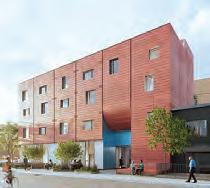









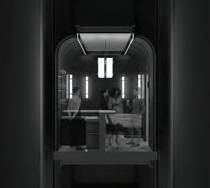





Specialized technical skills—such as expertise in sustainability, computational design, heritage, energy modelling, and construction detailing— are often associated with male architects. As Vice Chair of the Advisory Committee of BEAT (Building Equality in Architecture Toronto), I had the pleasure of supporting a recent seminar that aimed to counter that bias. The day-long event featured five women who have developed in-depth technical knowledge as a key part of their career journeys.
The day’s moderator—and the curator of the panel—was Jennifer Davis, strategic business development lead at WZMH Architects. Jennifer spoke about how she began stacking skills sets in a succession of personal and professional projects—taking on construction detailing in architecture offices, then applying those abilities to her own public art projects, which in turn led to the development of a proficiency in proposalwriting. At WZMH, she wrote her own job description for a role where she creates business development opportunities based on the firm’s technical expertise. A recent project involved leading a publication and presentation series that showcases the firm’s extensive experience in re-cladding towers.
Dima Cook, a principal and director at EVOQ A rchitecture, described how, early in her career, she lucked into being part of a project team rehabilitating the Harbour Commission Building in Old Montreal, which she had studied in university. Over time, she built up the expertise and appetite for detailed on-the-ground investigation that characterize her work. She has long had the benefit of a female mentor—heritage doyenne Julia Gersovitz—but still encounters friction on construction sites, where crews are predominantly male. “I come across the guy who says, ‘I’ve been mixing mortar for 30 years,’” says Dima, “and I say, ‘so have I, and we’re doing it my way.’”
Kendra Kusick is a project manager and digital tools expert with Teeple Architects. Her work is also research-intensive, involving diving deep into Excel spreadsheets and Revit errors, often through online forums, and persisting until
ABOVE Dima Cook speaks as part of a day-long BEAT event on women architects in technical roles.
finding a solution. She advocates for the value of good work to speak for itself, referring to times when her office has taken up efficiency-oriented processes she’s developed, without her having to explicitly advocate for their adoption. But she is also on guard about being pigeonholed in her specialty, or taking on tasks because others are complacent about learning basic skills—a sentiment echoed by the other panellists.
Sophie Tremblay, an associate at LGA Architectural Partners, built up her abilities through hands-on work detailing energy efficiency retrofits for a series of city-owned social housing projects. Wanting to go further in developing her expertise in envelope detailing, she approached the partners to support training for Passive House certification at an advantageous time: the firm had just missed a few opportunities because they didn’t have a certified Passive House designer.
Olivia Keung, an associate at Moriyama Teshima Architects, came to a specialty in sustainability out of a desire to make the greatest positive impact in the profession. The intersection between social and environmental sustainability is evident in projects she is involved with—including an expansion to Sudbury’s Science North— as well as her committee work as sustainability advisor for the City of Toronto’s Design Review Panel, and on the RAIC ’s Advisory Committee for Promoting Equity and Justice.
Advocating for women to take on more technically oriented roles is part of Olivia’s passion: early in her career, she observed how men were often picked to take on “meatier” tasks and projects, and how that led to them making quicker gains in expertise, status, and salary. “If they can do it, so can I,” she concluded—as did the other panellists. They hope to inspire other women to follow in parallel paths—and to encourage allies in the industry to support the diversity of people looking to put in the time, hard work, determination, and brain power needed to gain specialized technical expertise.
EDITOR
ELSA LAM, FRAIC, HON. OAA
ART DIRECTOR
ROY GAIOT
CONTRIBUTING
EDITORS
ANNMARIE ADAMS, FRAIC
ODILE HÉNAULT
LISA LANDRUM, MAA, AIA, FRAIC
DOUGLAS MACLEOD, NCARB FRAIC
ADELE WEDER, FRAIC
ONLINE EDITOR
LUCY MAZZUCCO
SUSTAINABILITY ADVISOR
ANNE LISSETT, ARCHITECT AIBC, LEED BD+C
VICE PRESIDENT & SENIOR PUBLISHER
STEVE WILSON 416-441-2085 x3
SWILSON@CANADIANARCHITECT.COM
ASSOCIATE PUBLISHER
FARIA AHMED 416 441-2085 x5
FAHMED@CANADIANARCHITECT.COM
CIRCULATION


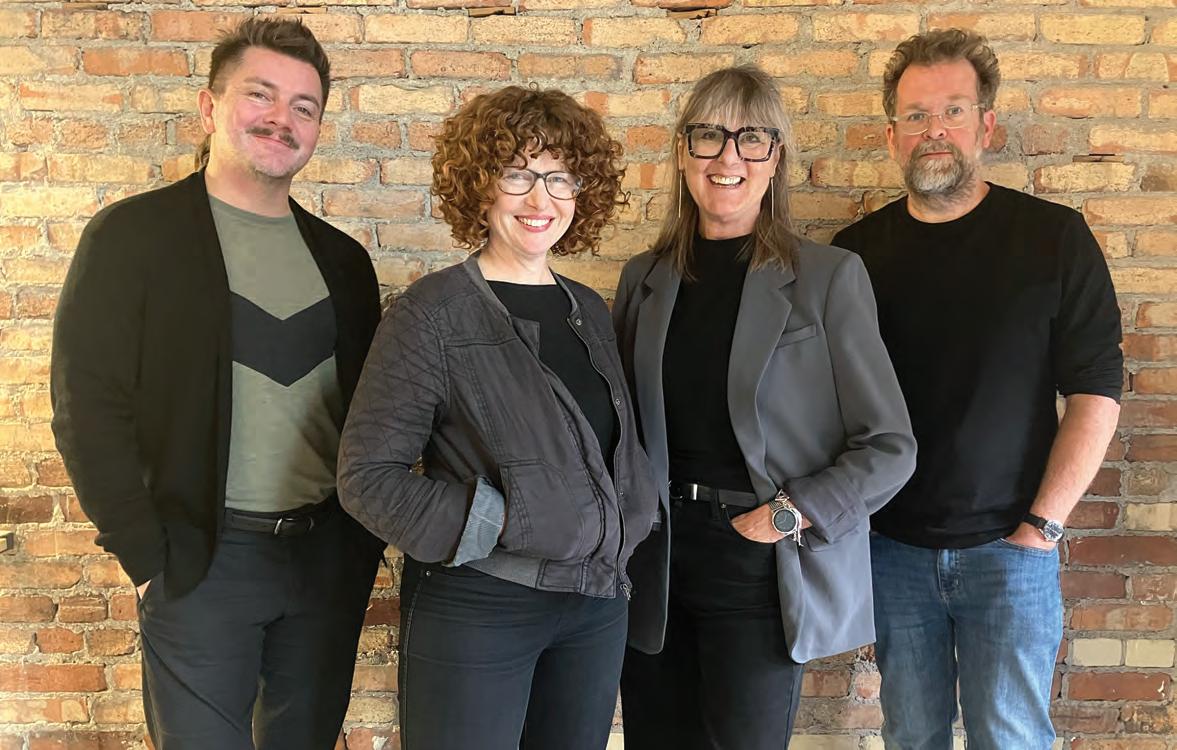
The 2024 Canadian Architect Awards were tightly contended. Over two days of deliberation in October, jurors Andrea Wolff, Matthew Hickey, and D’Arcy Jones considered 143 entries to arrive at a selection of four Awards of Excellence winners and six Award of Merit winners. They also considered 35 student entries the top architecture thesis projects in Canada as nominated by their schools to select three Student Award of Excellence winners.
Photographer Lisa Stinner-Kun joined the jury to select one Photo Award of Excellence winner and two Photo Award of Merit winners. In our newly introduced Student Photo category, one entry was selected to receive a Student Photo Award of Excellence.
This year’s winners expertly balance design ambition, sustainability considerations, and a humanistic social vision. Going beyond the expected resolutions to a given program, they dug hard to develop design solutions that leveraged existing contexts, minimized environmental impact, and were generous in their provision of amenity.
These qualities are especially evident in the winning projects which work closely with existing buildings. There is growing industry-wide realization that, in terms of sustainability, the greenest buildings are those that are already built. According to the AIA, around half of the current work of architects involves adaptive reuse, renovation, or additions to existing structures. The most successful of these projects not










only show a deep appreciation of the social, historic, and cultural values embedded in existing buildings, but also integrate these values thoughtfully into new design interventions.
The Confederation Centre of the Arts Revitalization, by Abbott Brown Architects, renovates and carefully adds to the 1964 project by Affleck, Desbarats, Dimakopoulos, Lebensold and Sise the first of Canada’s Centennial buildings. The project includes needed accessibility and energy upgrades, as well as the additions of a stage-sized rehearsal hall, new classrooms and learning areas for visual arts, theatre, and dance, and artist-in-residence spaces. A new street-level entrance creates a warm, open welcome, subtly softening the Brutalist design.
On the West Coast, the revitalization of the Tofino Fish Pier, by Leckie Studio Architecture + Design, transforms a different kind of historic structure an artifact of industrial heritage. The original fish pier housed an ice plant that served the area’s deep-sea fisheries. The wooden structure for that ice plant remains at the heart of the design, with its large-scale spaces now being leveraged as gallery and gathering spaces. In a powerful pivot, the former colonial structures are being revitalized for use by Indigenous communities and fishers, recognizing and supporting their legally affirmed harvesting rights.
A third project involving an existing building in this case, a major addition is located near downtown Montreal. The Éva-Circé-Côté














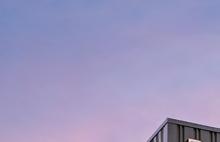































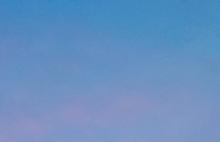
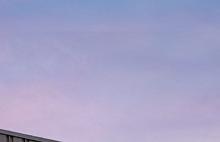





































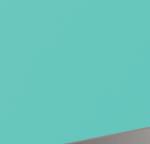

























































metal panels mimic signature sculpture
Parc Haven features industrial-style PAC-CLAD Highline B2 metal cladding that references the adjoining train tracks. A punch of colourful Flush panel highlights nod to Symphony Park’s Pipe Dream sculpture sited directly across the street.




























Library, by Lapointe Magne et associés architectes working in consortium with L’OEUF Architectes, expands a library currently housed in a former fire hall; the project restores the envelope of the heritage building and frames it with a triangular addition. Beyond its impressive sustainability figures an EUI of 97.22 kW h/m 2 /year, a TEDI of 26.94 kW h/m 2 /year, and WUI of 0.081 m 3/m 2 /year the project conserves large existing trees to shade new spaces, reuses construction waste, and draws on local supply chains. It also encourages community agriculture and active transportation, reasoning that helping to instigate even small changes in the transportation and consumption habits of users can help to reduce the neighbourhood’s carbon footprint in an impactful way.
One of the winning student projects also engages deeply in the adaptive reuse of a building. Matthew Dlugosz’s thesis project, entitled Parkdale People’s Palace, proposes the renovation of an existing church in a central-west Toronto neighbourhood to become a local community food hub, with layered uses including a co-op grocery store, community kitchen, community garden plots, a flexible dining and co-working hall, and a farmer’s market.
Rosalie Laflamme’s thesis project, Heritage of a Rural Patrimony, demonstrates a similar sensitivity to its context in this case, the rural centre of Petite-Rivière-de-Saint-François, Quebec. Casting an eye to rural industry, it proposes a centre for reviving traditional arts combining areas for boat building, carpentry, maple syrup manufacturing, and preparing eels harvested through weir fishing. Like the program, the architecture of the paired buildings draws on vernacular forms and local materials.
Although it did not quite make the cut, another project that was much discussed by the jury was NinetySeven Victoria, by bnkc architecture + urban design. Located in Kitchener, Ontario, the project addresses the absence of affordable housing with an initiative to create a “campus
of care” a grouping of buildings that combines transitional housing, mental health and addiction support, and community food programs. The project includes a renovation and addition to an existing warehouse, as well as a new building on the host organization’s current site. The jurors applauded the approach of evolving a warehouse into a courtyard-centered campus, although they felt that the addition to the existing building could be handled with a more elegant touch.
Another group of winners that deal closely with their immediate surroundings in exemplary ways are urban infill projects. Montreal Old Port Infill, by architecture écologique’s Étienne Lemay, is a slim building that replaces a previous structure that burned down in 1959. While just 18 feet wide, it makes subtle allusions to its predecessor, adopting the previous building’s rounded corners and marking the height of the previous parapet with a change in stone texture.
Two infill projects are among the Toronto project winners. Annex House, the first built commission by Harry Wei’s firm WAO (Wei Architecture and Objects) combines three homes on a single-family lot. Units in the main house are interlocked and arranged to prioritize access to natural light, including on the lower level. The design aims to fit in, rather than stand out elegantly integrating extra density into an established neighbourhood.
Located in Toronto’s Parkdale neighbourhood, 11 Brock Avenue, by SvN Architects + Planners, aims to deliver 40 new supportive and rent-geared-to-income residential units on a vacant lot. The units are grouped around a courtyard, providing daylight and a dedicated outdoor space for residents, while the street façade is a lightly playful composition, accented by soft curves that transform into a canopy and bench-height informal seating to extend a warm welcome to residents and neighbours. A second project by SvN was also discussed by the jury, although in the
end they felt that a more convincing deployment on an actual site would have been needed to consider it more thoroughly as a possible winner. Cabin Communities addresses the lack of options for unhoused people in Toronto by introducing prefabricated, mass timber cabins that could be rapidly built and deployed in neighbourhood vacant lots. The cabins are grouped around a central shared space with access to a community kitchen, dining area, washroom facilities, and laundry. Designed using Passive House principles and with residents’ comfort in mind, the cabins provide dignified, secure temporary homes as a step for residents to transition into more permanent housing.
Programmatic innovation is at the heart of several other projects. Coronation Park Sports and Recreation Centre, by hcma architecture + design and Dub Architects, in collaboration with FaulknerBrowns, is a dynamic combination of a velodrome with a community sports hub a departure from the usual configuration of velodromes as standalone facilities. The cycling track is positioned a full story above the centre’s ground-level infield courts, with a four-lane running track looping below and outboard the cycling area. Creating visibility between different sporting uses aims to generate broader community interest in track cycling and triathlon.
On a more modest scale, The Open, a project in Calgary by Public City Architecture, adds a sporting function to what might otherwise be a prosaic washroom project. Pairing a pickleball court with a greenroof-capped public washroom helps to generate activity and interest, adding to the vibrancy, visibility and safety of the facility.
Student Jose Power’s thesis, Ascending Worlds, brings an inventive eye to the space of the residential elevator. Reflecting on the early days of elevators when the new mechanized devices were rendered as luxurious moving rooms, to dispel anxieties about living at height Power explores the potential of elevators to serve as miniature social condensers.
24_011992_Canadian_Architect_DEC_CN Mod: October 21, 2024 3:25 PM Print: 11/01/24 4:29:34 PM page 1 v7

We provide over 42,000 shipping, packaging and industrial supplies to businesses across North America. From tape and tags to boxes and bubble, everything’s in stock. Order by 6 PM for same day shipping. Best service and selection – experience the difference. Please call 1-800-295-5510 or visit uline.ca


ABOVE SvN’s design for Cabin Communities was notable for its considered vision for pre-fab, modular tiny homes that could be grouped together on vacant municipal sites to offer transitional housing.
His whimsical catalogue of proposals includes retrofitting elevators as cocktail bars, mini-sized concert venues, and micro libraries. Two final winning projects offer innovation in the realms of construction process and form. Mont-Laurier Library, by Chevalier Morales with L’OEUF Architectes, is based on a wooden reciprocal frame

structure a kind of waffle slab made out of mass timber. The design is engineered for disassembly, envisioning the future reuse of the building’s materials as its original use changes.
Warehouse Park Pavilion, a pavilion by gh3*, is located in an Edmonton park whose design is being led by CCx A . The barrel-vaulted, berry-red structure nods to mid-century styles, while also offering a distinctive contemporary presence. Its red colour alludes to the pavilion’s adjacency to a fire-pit-equipped warming plaza a space meant to offer respite during wintry weather.
A final project that drew especial attention from the jury, although it was not ultimately selected as a winner, was Ja Architecture’s The Grounding Meadow. The project was the winning entry in a recent competition to revamp the landscape design for the Ontario Association of Architects’ headquarters in north Toronto. It proposes the removal of nonpermeable hardscapes and their replacement with a wild meadow that allows for on-site stormwater treatment through filtration and sedimentation. The meadow is overlaid with a permeable metal grid that bridges to the parking and pedestrian entrances. The jurors were intrigued by the design strategy that tightly integrated architectural and landscape thinking although this quality also, they felt, made it difficult to evaluate the project within the framework of an architectural competition.
Among the photos, one image by Montreal- and London-based photographer James Brittain stood out: a photo of École du Zenith, an elementary school recently completed by Pelletier de Fontenay and Leclerc Architectes. They were particularly taken by the image’s expert composition which didn’t feel forced, but rather like a perfect found moment.
Another image by James Brittain was also selected for recognition: his image of Provencher_Roy’s Le Tour du Port in Montreal. The jury noted the compositional strength of an image that includes several existing structures in a way that gives them a sense of purposeful placement, and the natural lighting that allows the tower to appear transparent, rather than reflective.
Jacqueline Young of Stationpoint Photographic was the photographer behind the third professional photo selected for recognition. Her image of Douglas Cardinal’s St. Albert Place was noted for its craftsmanship, visible in the amount of detail brought out, and in treating the shadows as being as important as the architecture itself.
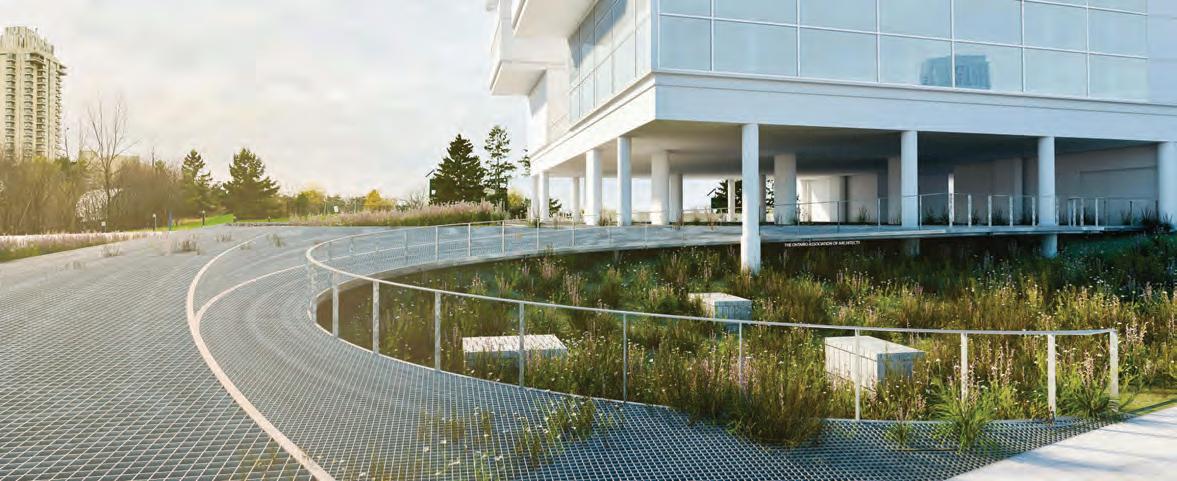
ABOVE The Grounding Meadow, by Ja Architecture, was selected as the winning proposal in a design competition for revisioning the landscape of the Ontario Association of Architects’ headquarters. The jury admired the integration of landscape and architecture in the design.
The resulting image presents a lovely ambiguity between being an architectural image, and an almost abstract composition.
For the first time this year, our Photo Awards of Excellence included a category for students. One image stood out from the dozens received: Jenna Bosc’s photo of the Église Précieux-Sang, a Winnipeg church by
Étienne Gaboury. The jurors found the image remarkable for its technical capture of detail, and for offering a surprising view of a familiar landmark.
Canadian Architect offers its congratulations to all of this year’s winners, and our sincere appreciation for all those who offered their work for consideration by our jury.








Abbott Brown Architects was founded in 2013 by Alec Brown and Jane Abbott. Prior to joining forces, Alec had worked with practices in Vancouver, London and Berlin, and Jane had a successful career in theatre design in Toronto and Copenhagen. Both partners have taught design at the Dalhousie School of Architecture. The office currently has a staff of seven. Abbott Brown has earned a reputation for cultivating bold, responsive design solutions, particularly in public and historic contexts. The office has a non-dogmatic attitude to uncovering opportunities and approaches inherent in every project. An attitude of experimentation and even whimsy often enriches an overall respect for physical and cultural context.
The emphasis is on developing and championing effective design that balances the richness of extant formal patterns with re-animated and re-considered approaches to space, detail and the user experience. The office aims to maintain a balance between bespoke small residential projects and large cultural and public-sector commissions. The office has particular experience with interventions celebrating historic contexts, including at the Highland Village Museum in Cape Breton, infill in Lunenburg’s UNESCO Old Town, and projects at Halifax City Hall, Dalhousie University and the University of Kings College.
architecture écologique is dedicated to creating projects that harmonize with their surroundings, while prioritizing environmental responsibility. The firm emphasizes resilience, energy efficiency, and ecological balance, resulting in vibrant, livable spaces that resonate with both people and the planet. The studio engages closely with its clients to consider the unique characteristics of their sites. By collaborating with great builders and professionals throughout the design process, we ensure every project is tailored to its environment. This commitment reflects a deep respect for the beauty of our natural world and each local building culture. By using renewable materials and integrating traditional and advanced building technologies, the firm minimizes its ecological footprint while maximizing comfort and functionality. Good design must incorporate environmental sustainability. Architecture écologique caters to design enthusiasts eager to minimize their environmental impact, thus positioning architecture as a catalyst for positive change, and creating spaces that inspire and nurture.


SvN is a multidisciplinary design firm working to solve the greatest challenges faced by rapidly growing cities worldwide. Our practice is about more than simply built form it’s about building ideas for how we will live in the 21st century in a way that supports healthy ecologies. We are committed to building regenerative communities, fostering the economic, social, cultural, and environmental impacts needed to move our world forward. We recognize that positive change lies in our ability to adapt, evolve, and improve the world around us. We work with governments, institutions, developers and community-based organizations
WAREHOUSE PARK PAVILION

to create complete and resilient neighbourhoods, active and public transit infrastructure, and vibrant public spaces. Our designs are sensitive to local history, environments and cultures allowing people to maintain an ongoing sense of connection to their communities as they grow and evolve. We guide both public- and private-sector projects in pursuit of value-creation for stakeholders, and quality of life for people and the planet. We value the quality of relationships, building connections between people, places, and the natural world, so that every interaction is enriched with meaning and purpose.
gh3* is an internationally recognized practice based in Toronto. Our office works in the increasingly complex realm where architecture, urbanism and landscape overlap. gh3* is defined by a unique capability to take on complex and demanding projects and to distill these into conceptually straightforward, architecturally significant, civic-minded places and buildings. We do this with a research-based, iterative, and inquisitive approach that challenges the status quo, examines long-held assumptions, and proves that there is always space for innovation and improvement.
Since its founding, the practice has delivered award-winning projects that go beyond expectation. Optimists at heart, we embrace every project as an opportunity to create something of lasting value, rigour and beauty. We have completed projects at every scale, from small park pavilions and private houses to large civic and transit infrastructure. Recent and ongoing projects include the final phase of Toronto’s Regent Park Revitalization, the Olympic Plaza Transformation in Calgary, and Project Bench in the Niagara Benchlands. We are also currently developing the Tamil Community Centre in Scarborough, which reflects our commitment to designing spaces that resonate with the communities they serve.
Our energetic and interdisciplinary team is committed to the best in creative practice. We bring a tailored, client-centred approach to every stage of the design and construction process, with the aim of achieving pragmatic, poetic, environmentally responsible, and aesthetically powerful design solutions. We believe that excellent design is an essential part of everyday life, and that spatially and visually engaging places can inspire joy and civic pride.

LEFT TO RIGHT, TOP TO BOTTOM LM&a: Katarina Cernacek, Florian Vadjoux, Qiang Fu, Martin-F. Daigle, Soubhi Jabal. Not Pictured: Pascale-Lise Collin, Émilie Maumy, Océane Perham. L’OEUF: Sudhir Suri, Edith Beauvais-Sauro, Foti Boulougaris. Not Pictured: Jennifer Benis, Aradhana Gupta, Bahia Burias, Camille Debuisne, Chloé Deblois, Ariane Ducharme
Lapointe Magne et associés , a mid-sized architectural firm based in Montreal, was established more than 60 years ago and works primarily in the public sector. Its projects include universities, schools, museums, libraries, cultural and sports complexes, civic buildings, and social housing. The work stands out for its proven experience in re-weaving the city by enhancing and reframing existing contexts. Known for its sensitivity to details, LM&a approaches every project with material and formal inventiveness. Using a multi-disciplinary and deeply collaborative approach, the team is dedicated to creating sustainable, resilient, beautiful architecture that is attentive to its context but stands out, that protects resources, and that actively contributes to well-being, culture, and society.
L’OEUF Architectes is recognized for translating client needs into innovative, sustainable design. Our holistic approach balances innovation, social equity, economics and collaborative process. These values have guided us for over 30 years, creating ideas that can change the world. The best results come from projects that are inspired by and rooted in communities, from local to global. This multi-stakeholder process is why listening is at the heart of our work. Our team is diverse: many generations, backgrounds, and cultures. We’re all different, but united by a single passion: designing beautiful, sustainable places. We create meaningful projects for everybody. We design places in harmony with local ambient ecosystems, enhancing quality of life. These are the commitments L’OEUF makes to all its clients, without exception: we listen to communities, we adhere firmly to shared values, and we work hard to create a better, more realistic, and more beautiful future.

Wei Architecture & Objects (WAO) is a Toronto-based architecture and design practice led by Harry Wei. It was founded in 2022 with a commitment to finding design solutions that resonate within their particular context, building a narrative based on existing specificities. WAO believes that every design project should evolve as a process of exploration and extraction rooted in site, program, bylaws, and client requirements. Through experimentation with material and construction technique, WAO is able to produce distinct tectonic relationships that appear simultaneously primitive and sophisticated, respectful of tradition while also radically contemporary.
Prior to founding WAO, Harry was a Senior Architect at Herzog & de Meuron, where he held leadership roles on several cultural and residential projects, including the Badaevskiy Brewery Redevelopment in Moscow, the Grand Canal Museum in Hangzhou, and the National Library of Israel in Jerusalem. He has also previously worked for MAD, NL Architects, and BIG. Parallel to practice, Harry is currently a lecturer at the University of Toronto and at the University of Waterloo. Annex House will be WAO ’s first built commission.

Public City is an architecture and landscape architecture practice rooted in an exploration of the public realm. The firm’s playful philosophy approaches design as “public life support.” Since 2016, when Winnipegbased Plain Projects and Peter Sampson Architecture Studio joined forces, the work of Public City has examined public infrastructure as an active agent in civic life. Known for some of its smaller vibrant and award-winning works, Public City has a diverse portfolio that includes libraries, schools, and other public commissions across Canada. Most recently, the firm won an international design competition for the 2SLGBTQI+ National Monument, which is now under construction in Ottawa. The studio has a history of transforming familiar objects and programs like shipping containers, parking lots, disco balls, and washrooms into layered mashups of community and social interaction. This is the firm’s first Canadian Architect Award as Public City, but third overall, with previous awards being given to its predecessor firm in 2013 and founding architect in 1999. In 2022, the firm was awarded a Governor General’s Medal in Architecture. With studios in Winnipeg, Toronto, and Edmonton, Public City is committed to a practice of well-being in the Canadian urban public realm by design.
Chevalier Morales is a Montreal-based architecture and design firm founded in 2005, operating on both provincial and national levels. Its founders, Stephan Chevalier and Sergio Morales, embrace a contemporary vision of architecture that carries social and environmental responsibility while ensuring a connection to the surrounding context. Known for their sensible and imaginative approach, Stephan, Sergio, and their team strive to reflect contemporary ambitions and concerns regarding social, cultural, and environmental issues. Committed to innovation, they continually explore new ways to address these challenges in the construction and design of buildings.
The firm is driven by a clear commitment to the realities that characterize its time. With a talented team of around fifty collaborators, the firm has established itself as a major contributor to the architectural Canadian landscape. Chevalier Morales has a diverse portfolio that primarily focuses on culture, higher education, workspaces, and both social and private housing.
The firm also offers specialized expertise in the restoration and rehabilitation of built heritage. Recognized by peers and the broader community, Chevalier Morales has been featured in national and international publications and has received numerous accolades, including the RAIC ’s 2018 Emerging Architectural Practice Award, two Grand Prix from the Ordre des architectes du Québec, two Governor General’s Medals in Architecture, and several Canadian Architect Awards.
Most recently, the firm was a finalist to officially represent Canada at the 18th International Architecture Biennale in Venice. Through the dedication of its partners and team members, Chevalier Morales actively contributes to both professional architecture and academia, fostering the next generation of ideas through their engagement in higher education.



















Order samples of Timber Series MCM finishes


Be inspired by nature, not restricted by it. Choose endlessly adaptable ALPOLIC® metal composite materials for the natural look of wood, without the weight, maintenance difficulties or expense. For both interior and exterior applications, our Timber Series finishes provide the realistic natural wood appearance you’re looking for, along with the superior performance and value you expect from ALPOLIC® .

















hcma: Michael Henderson (MIRAC), Darryl Condon (FRAIC), Paul Fast (MIRAC), Michael Rivest (MIRAC), Darin Harding, Derek Harris, Jennifer Sparks, Carter Gallant, Wendy Li, Jasmine Lam, Genevieve Simms, James Kokotilo, Nathan Keebler, Marcus Van Vliet, Alice Rooney, Aaron Bohnert Dub Architects: Michael Dub (MIRAC), Bobby Harris (MIRAC), Gene Dub, Cass Milford, Graeme Haunholter. Not Pictured: Stephen Smolski, Ciaran Bonar, Chris Woodroffe. FaulknerBrowns: Michael Hall, Sherief El-Salamani, Paul Rigby, Archie Wang, David Noble, Andrew Parkin, Shirley Lui, Cristina Ubeda
hcma designs buildings, brands, and shared experiences that connect people. We believe that with collective strength, communities can work together to make a difference to the issues that matter. Collective strength empowers our practice, too. Driven by relentless curiosity, we work as one to solve complex problems from every angle. We advocate for inclusive, accessible design that embraces everyone, and minimizes environmental impact.
Dub Architects was established in Edmonton in 1975. Through an extensive body of work in commercial, residential, and institutional projects,
it has earned a reputation for design excellence in Alberta. The firm’s goal is to design environments that delight occupants, operate efficiently and sustainably, and build legacies in their communities.
FaulknerBrowns are internationally recognised designers of places where people do better. From studios in the UK , Canada and Ireland, we are creative specialists and typological innovators. We have a long-established reputation for designing innovative and operationally successful buildings and masterplans globally.

Leckie Studio Architecture + Design is an ambitious inter-disciplinary design studio based in Vancouver. The studio was founded in 2015 by principal architect Michael Leckie with the goal of pushing the traditional boundaries of architectural practice as a catalyst for cultural change. We engage in the practice of design across a variety of scales and media including architecture, interiors, installations, and product design. We challenge assumptions and seek unexpected outcomes. The studio’s work has been published internationally, with a client list that includes industry leaders Slack Technologies, Westbank, UBC, and TELUS
Our residential, commercial, and institutional projects are informed by a critical regionalist sensitivity, with an emphasis on scenario-based approaches to program, form, and sustainability. Our design process is committed to a rigorous process of discovery: the core of the practice relies on a deeply rooted fascination with the act of making. We are fundamentally creative problem-solvers and design thinkers and
understand that the process of delivering a design solution is as important as the formulation of the design solution itself.
Leckie Studio has been afforded the opportunity for strategic growth to now include 18 staff members, allowing us to tackle projects of substantial size and complexity. The core studio team consists of seven registered architects (British Columbia, Nova Scotia, and Ontario). The architect team leads are supported by architectural interns/graduates with varying specializations including interior design, prefabrication, mass-timber, industrial design, digital fabrication, graphic design, and architectural visualization. The studio team also includes an industrial designer, a communications designer, and operations/administration support staff. Our architects have been trained by and have worked alongside the world’s preeminent names in architecture in Canada and abroad.



Originally from Charlevoix, Quebec, Rosalie Laflamme began her architecture studies at Université Laval in 2019 and completed her bachelor’s degree at ENSA Val De Seine in Paris. Back in Quebec, she continued her Master’s program and, in June 2023, took part in a humanitarian internship with the UNESCO Chair, contributing to the creation of a shading structure on the island of Carabane, Senegal. Her interest in heritage and regionalism inspires the subject of her project thesis, Heritage of a Rural Patrimony. She is currently completing an internship at CCM2.


Matthew Dlugosz is an intern architect at Gow Hastings Architects and is a graduate of the Bachelor’s and Master’s programs at the University of Waterloo’s School of Architecture. His thesis, focused on church disuse and social infrastructure within urban Toronto, earned him the Ontario Graduate Scholarship and the ARCC King Student Medal. He is interested in the potential of architecture to create meaningful connections between people and place.

Jose Power holds a Master of Architecture from the University of Toronto, where he also completed an Honours Bachelor of Arts in Architecture with High Distinction. Upon graduating, he was awarded the Academic Honours Certificate, the Faculty Design Prize, and the Alpha Rho Chi Medal in recognition of his leadership, service to the school, and potential for professional excellence. An enduring curiosity about cities and urban life particularly with improving life within high-rise buildings led to his thesis, Ascending Worlds, which explores the overlooked potential of elevators in enhancing urban living.

James Brittain is a photographer working from Montreal and London, UK . Over 23 years of commissioned practice, he has established an international reputation for pictures grounded in the experience of architecture. His work is widely published in books and magazines around the world.
Brittain has been the principal photographer for a number of recent books about architecture, including platform.MIDDLE: Architecture for Housing the 99%, by Canada’s 5468796 Architecture, published earlier this year, and a new volume about the art and architecture of the UK’s Kensington Palace (Yale University Press).
Brittain uses his commissioned work to support his own photographic practice. His personal work has been exhibited at the Contact Photography Festival in Toronto and at the Architectural Association in London, UK

Jacqueline Young , owner and principal photographer at Stationpoint Photographic, is an award-winning Treaty 1-based Photographer of Architecture and Sessional Instructor at the University of Manitoba. She formally trained in architecture at the University of Manitoba, and in photography at PrairieView School of Photography. Her enthusiasm for documentation comes from her fondness for the technical structure of the photographic process, combined with the pursuit of expressing the ephemeral nature of light and people moving throughout the built environment. Young chooses to focus her practice on capturing what is present, rather than chasing “the ideal.”

Jenna Bosc is currently completing her final year in the Environmental Design program at the University of Manitoba. Her interests lie in urban design, placemaking, and affordable housing. Through her work, Jenna designs spaces that foster meaningful relationships between people and the built environment. For instance, one project explored how formal and spatial qualities influence human interaction through the integration of courtyards with varying degrees of privacy. Drawing from principles of narrative-based design, Jenna aims to develop spaces that tell powerful stories and facilitate the conception of new ones. Jenna is actively involved in the Student Architectural Society (SAS) and the Indigenous Design and Planning Student Association (IDPSA) as graphic designer, aiding in the creation of promotional material for both organizations. She is currently interning at Landmark Planning & Design Inc. in Winnipeg.





LOCATION Charlottetown, Prince Edward Island
ARCHITECT Abbott Brown Architects
Thoughtful, elegant, and inclusive. This strong intervention into the Brutalist architecture of the Confederation Centre of the Arts is an example of how 1960s architecture can be elevated to today’s standards of community. Prioritizing a street-level entrance changes the proportions of the existing façade, creating an entry that feels like it has always been there. The additional masses reference the heritage forms while skillfully creating contrast through materiality, considered fenestration, and a slight reveal that allows the forms to visually slide past each other. Ultimately, the new intervention strengthens the entire site. – Matthew Hickey, juror
The Confederation Centre of the Arts (CCoA), in Charlottetown, PEI, is a textbook example of how an initially acclaimed effort by architects of one generation to design something noble, egalitarian, and enduring can look exclusionist and problematic several decades later.
Designed by Affleck, Desbarats, Dimakopoulos, Lebensold and Sise and completed in 1964, this Brutalist National Historic Site conceived as “Canada’s national memorial to the Fathers of Confederation” originally consisted of library, theatre, and art gallery buildings, extruded up through
a podium edged with terraced planters, and framing a sunken courtyard.
“The original intent of Brutalist architecture,” as Abbott Brown Architects notes in the award submission, “was to dislocate it from the normative iconography of power and make it accessible and empowering to all.”
Today, however, the CCoA’s physical inaccessibility and aloofness feels alienating and out of step with Canada’s heterogeneity. Prior to design work on this project, Abbott Brown co-sponsored a conference at which artists and others from diverse backgrounds explained why the very cultural centres meant to embody their voices felt uncomfortable and unwelcoming.
Drawing from the insights of that gathering, the Phase 1 Revitalization will transform and expand the former library pavilion into a new National Cultural Leadership Institute, which will offer a hub for convening on important Canadian issues, arts and cultural learning programs, as well as spaces for Canadian arts creation and hosting community events.
Abbott Brown’s intent is to preserve the integrity of the original architecture, while subverting its impenetrable character. New construction is restricted to the interstitial zones between the existing volumes, and













































































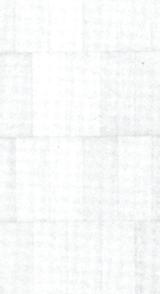


















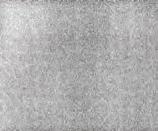


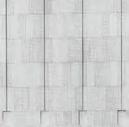















ABOVE Mass timber bridges and structural elements weave through the existing volumes, introducing barrier-free access routes and adding warmth to the concrete heritage building.
Mass
and
to the adjacent plaza. Removing a swath of the perimeter terracing along Richmond Street, inserting new glazing, and situating a new atrium floor at grade opens one of the pavilions directly to the street. Within, the mass timber structure of the new connecting volumes takes the chill off the existing expanses of exposed concrete. Removing portions of the original Level 2 and Level 3 floors and inserting a translucent, loadbearing stair just below street level creates new atrium space at street level. The interstitial interventions also establish a new opening to the CCoA’s sunken Garden Courtyard.
In contrast with the original complex’s monolithically blank sandstone exterior walls, the cladding of the new additions combines generous glazing with panels formed from irregular, glazed, terracotta ribs. While keeping within an overall bone-white tonal range, the ribs will vary in profile, texture, and glazing. In this way, the manufactured panels will recall the subtle variations that are celebrated in the traditions of Japanese and Korean handcrafted ceramics. “The cladding itself is a subtle, luminous mosaic, offering the onlooker lively shifts and divergent impressions at different scales,” the award submission states. “It is an intentional, experiential metaphor for the complexity and diversity of contemporary society.”
Targeting CaGBC Zero Carbon Building – Design certification, this first phase of the CCoA’s revitalization preserves most of the existing mass-concrete structure, while introducing large central skylights, stack-effect ventilation, PV rooftop arrays, and many other strategies for improved energy performance.

CLIENT CONFEDERATION CENTRE OF THE ARTS ARCHITECT TEAM ALEC BROWN (MRAIC), JANE ABBOTT (MRAIC), JUNE JUNG, KATELYN LATHAM, KAREN MILLS, BLAKE KLOTZ, BRITTANY DWYER, CAMILA LIMA, SAEJIN LIM, CELINA ABBA, LEANNA LETTERIO, KALEY DOLEMAN, JACK ZIEMANSKI, TONY RUKONGWA, WILL MCINNES | STRUCTURAL/CIVIL
KALEY DOLEMAN, JACK ZIEMANSKI, TONY RUKONGWA, WILL MCINNES | STRUCTURAL/CIVIL SCL


ABOVE Rounded corners refer to the original building on the site, which burned down more than 50 years ago; a change in stone texture marks the earlier building’s parapet line. ABOVE RIGHT Openings on all elevations respond carefully to the adjacent building. OPPOSITE LEFT Historic drawings and photos served as key references in the design. OPPOSITE RIGHT Diagrams show how the previous structure informed the composition of the façades.

LOCATION Montreal, Quebec
ARCHITECT architecture écologique
This quiet infill project feels inevitable and fresh. The design strikes an intelligent balance between the modern and the historic as it rebuilds and abstracts the footprint of a previous structure that burned down in 1959. A modern mansard roof doubles as a shroud for unsightly mechanical equipment, a change in stone texture marks the parapet of the previous building, and each floor’s efficient planning responds to the stairs and exits of the adjacent building. – D’Arcy Jones, juror
An 18 x 80-foot sliver of real estate in Montreal’s Old Port district has been vacant since 1959, when the modest 19th-century warehouse that formerly occupied the site burned down. To state the obvious, any land parcel that has remained a pocket-size parking lot for more than six decades in this bustling tourism, dining, and shopping district must be fairly resistant to redevelopment. However, the owner of both this corner lot and the mixed-use heritage building adjacent to it determined that an infill building would be viable if it shared elevator and stair access with its neighbour to the east. Architecture écologique’s efficient design makes this happen, and it addresses the site’s challenges with urbane grace. Due to the topography’s southward slope, the existing building has five storeys along its Rue de la Commune façade, which overlooks the St. Lawrence River, and only four on its north façade, along Rue SaintPaul. It has retail tenancy at street level on Saint-Paul, and on the first



two floors along Rue de la Commune, with two levels of office space above that and a residential loft on level five. The infill building will have a similar disposition of retail space, plus five apartments on its upper four levels, ranging in size from a studio to a three-bedroom unit. The top two apartments are each two-floor stair-connected units, with an upper-level terrace. A mansard-like roof, echoing the form of many others in the district that became Montreal’s main port in the 1600s, tucks the mechanical equipment out of sight.
While clearly a building of its own time, the infill structure subtly alludes to its predecessor, echoing the fire-destroyed building’s rounded corners and marking the height of its parapet with a shift in stone texture.
Best known to date for rural, single-family residences, architecture écologique founder Etienne Lemay demonstrates a deft touch on this project for mixed-use infill in a heritage district. And as his firm’s name suggests, this building will have a small footprint, sustainably as well as literally: its above-ground structural system will be cross-laminated timber; its heating and cooling will be geothermal.


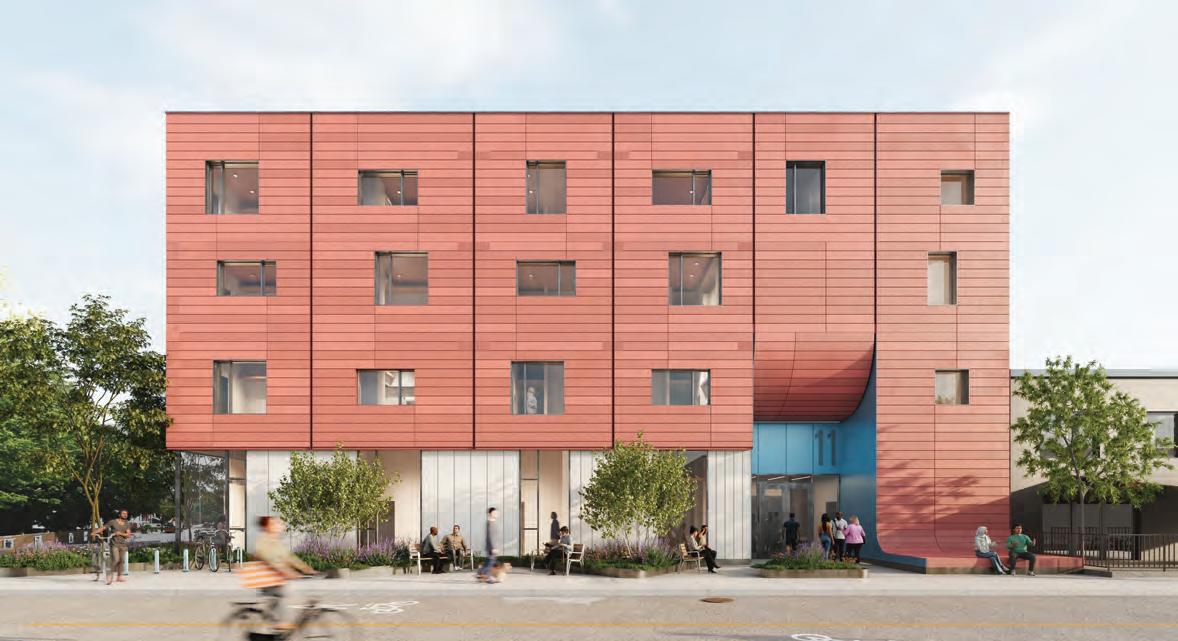
LOCATION Toronto, Ontario
ARCHITECT SvN Architects + Planners
The need for supportive housing is at a crisis point across Canada. 11 Brock Avenue not only addresses this need, but does so in a way that understands the effects of good design and the critical need for a baseline of net-zero and low carbon in building construction. This project prioritizes community through the design of an interior single-loaded corridor that promotes access to light and views to the communal spaces along the courtyard. The street façade expresses the rigour of mass timber construction, while still being playful and achieving a balance between opaque and transparent surfaces. – Matthew Hickey, juror
11 Brock Avenue is one of five projects resulting from a City of Toronto partnership with the Federal Government to create urgently needed supportive and affordable housing under the Rapid Housing Initiative. Targeting housing-ready sites, the initiative funds projects that are fasttracked from project start to occupancy within 18 months.
Located in Toronto’s central-west Parkdale neighbourhood, 11 Brock Avenue will provide 42 new supportive and rent-geared-to-income residential units on a corner lot that has been vacant for years. The building’s fine-grained, four-storey Brock Avenue façade is vertically divided into six bands, and animated by a couple of curves reminiscent of an old rolltop desk. One band demarcates the main entry by rolling inward above it; an adjacent band unrolls above the ground at bench height, creating an informal seating platform. Along the building’s west and north facades,
its landscaped border amps up visual interest by oscillating in plan between planting beds and hardscaped areas for seating and bicycle parking.
Several other congenial ideas coalesce in and around the building’s tiered, south-facing courtyard. At grade, the building’s dining hall and lounge, lobby corridor, and staff spaces all face onto a compact courtyard patio, providing the ‘eyes on the street’ that help make this secluded space feel like a safe, sociable hub. The laundry room, conceived here as a social space rather than a purely utilitarian one, also has a courtyard view. A series of outdoor areas cascade down towards the ground-floor patio: the topmost tier is a garden terrace, with picnic tables and raised accessible community-garden planting beds. Single-loaded corridors wrap the outdoor space on three sides, and include large window-boxes with seating, so that residents can sit by a window with views to the shared social area.
11 Brock Avenue is an all-electric, mass timber building, designed to meet net zero and low embodied carbon requirements. A wide band of extensive green roof aids in retaining stormwater and promotes biodiversity; the roof has also been designed to support a planned, future photovoltaics installation.
The layout of the residential units is optimized for simplicity and efficiency, and ensures privacy by not having any units face each other. Using a regular grid layout and repeating stacked suites improves the efficiency of the design and the speed of construction. More than 30 percent of the homes this project provides are accessible suites.

OPPOSITE The design aims to create a distinct, yet contextually sensitive addition to the Parkdale neighbourhood. The ground-level landscape includes native shrubs and trees, and hardscaped areas for seating and bicycle parking. ABOVE The tiered courtyard adjoins support spaces and common uses on the ground floor, and above, is wrapped with single-loaded corridors to the apartments.
GOVAN BROWN AND ASSOCIATES LTD., CITY OF TORONTO ARCHITECT TEAM AARON BUDD (MRAIC), SAM DUFAUX, JOSEPH KHAN, HAYLEY IMERMAN (MRAIC), HUGO FLAMMIN, JESSICA DAGA, EVAN WAKELIN, AZIZA ASAT, JINA LEE,


LOCATION Edmonton, Alberta
ARCHITECT gh3* (park design in collaboration with design lead CCxA)
Whimsical, yet structured, it is easy to imagine how this pavilion will become an icon for the city and create a gravitational pull for park users. The boldness of the vaulted roof structure and its consistent rhythm defies the organic shape in plan. With its strong monochromatic colour, it creates a distinctive, warm presence in the park. – Andrea Wolff, juror
Architecture is what separates a pavilion from a shed. Gh3*’s building for a pending park on the western edge of Edmonton’s downtown has a modest and largely utilitarian program: it contains washrooms, community multi-purpose space, mechanical and electrical rooms, storage space, and staff space. But this welcoming, emphatically red little building, topped with a yoo-hoo of a barrel-vaulted, cantilevered roof, looks set to become an instant local landmark. Warehouse Park Pavilion speaks, as its award submission notes, to a time when park pavilions were “celebratory.”
Reclaiming a former car dealership precinct as public green space, Warehouse Park aims to reconnect this part of Edmonton with its Indigenous roots. The name O-day’min, gifted by a local Elder to the ward in which the park is located, means “strawberry” or “heart-berry”
in Anishinaabemowin. The berry-red pavilion on the west side of the park will embrace and define the Warming Plaza (a.k.a. west plaza), a community space centred around a fire pit, and face toward the main, strawberry-shaped open lawn to the east.
The park’s geometry and organization generated the pavilion’s footprint. While the building encloses 270 m2, its irregularly shaped roof canopy stretches out to cover 400 m2, providing bountiful sheltered outdoor space in a configuration that aligns with surrounding park pathways. The pavilion’s large glazed areas, in combination with its relatively narrow width, allow for transparency and clear views from the alley along its west edge through to the public plaza to the east. Its robust exterior materials tempered laminated glass and powder-coated steel are graffiti resilient and resistant to vandalism.
This project’s barrel vaulting tips the hat to historic modern buildings in Edmonton such as Jasper Place High School and the Westwood Transit Garage and affirms that this ancient structural form lends itself anew to contemporary applications. The vaulted ceilings and interior walls, washrooms (including partitions) and event space are clad with red-stained marine grade plywood. Lest the site’s immediate past
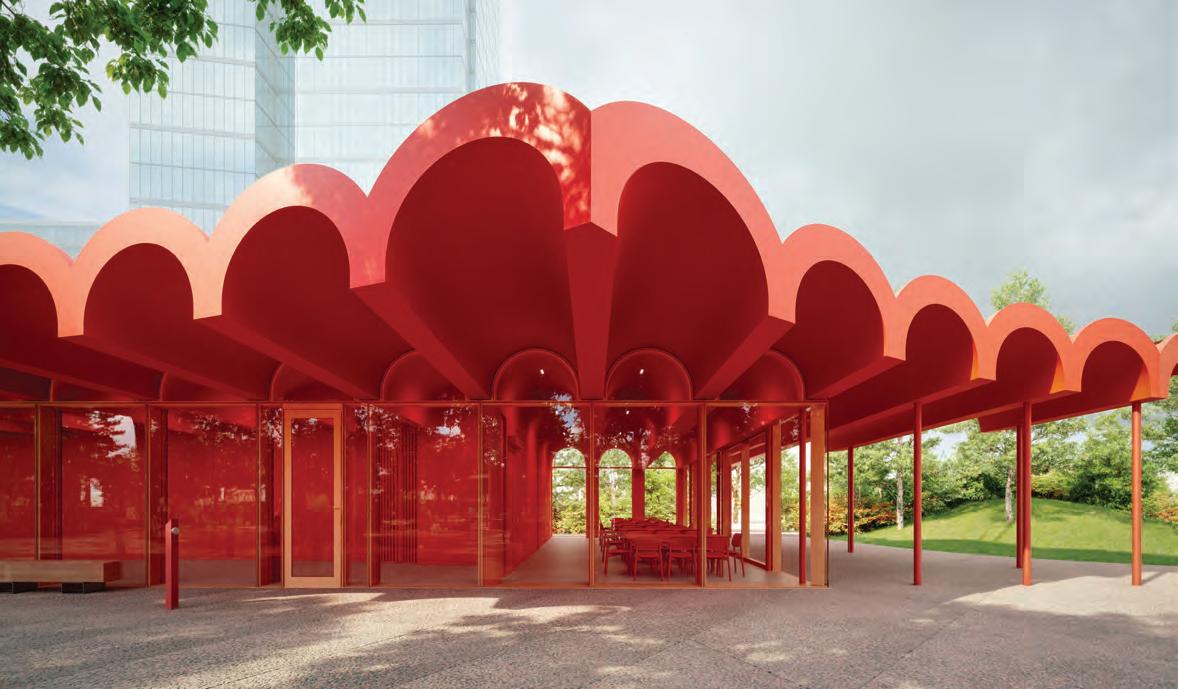
OPPOSITE The pavilion’s form and colour make it a beacon viewed from across the clearing, and an anchor on the west side of the park. ABOVE The dramatic cantilevered roof extends beyond the enclosure to create a covered outdoor space. Inside, amenities include universal washrooms, a multipurpose gathering space, and a kitchenette.





be forgot, the exterior areas of the pavilion’s cast-in-place concrete floor have an acid-etched, aggregate-exposing finish that mimics the old car dealerships’ durable terrazzo flooring, patches of which still remained in place after initial attempts to clear the site. (Interior public-area floors are polished concrete.)
The building is passively ventilated with no cooling; its deep roof overhang reduces solar gain and associated cooling loads.
Glowing a warm red even on a cold winter night and inviting all visitors to pause for a moment to enjoy its scalloped roofline, Warehouse Park Pavilion provides basic amenities with an uplifting generosity of spirit.



LOCATION Montreal, Quebec
ARCHITECTS Lapointe Magne et associés and L’OEUF Architectes, in consortium
This design demonstrates an understanding of the community, the character of the neighbourhood and the importance of preserving the existing Hibernia Park. The building footprint is reduced by stacking the program on three levels and allowing the public functions to spill out on the ground floor. The strength of this project lies on its relationship to the existing building and the park. The fluid organic forms at the ground floor open to the park, while the structured upper levels and asymmetrical, yet structured approach to the elevations act as a foil to the formality of the stone façade of the existing fire hall building. The low-budget, industrial approach to the structure adds to the charming and inviting nature of the building, and informs the expression of the façade.
– Andrea Wolff, juror
The physical and symbolic heart of Pointe-Saint-Charles, a historically working-class area in Montreal, is Hibernia Park and its old fire hall. 50 years ago, the community fought to preserve the fire hall as a means
to oppose development of a boulevard that would cut the neighbourhood in two. They stopped the boulevard, saved the fire hall, and transformed it into their municipal library.
The present addition will almost triple the size of the existing library. The City of Montreal conducted extensive public outreach and programming sessions with the local community prior to launching a competition for its design. However, the competition process excluded any ties between the designers and the community. To maintain the activist spirit of the community, the architects transformed their working process, inventing citizen-avatars people exchanging books, elderly people in a dance class, a teacher with their pupils and role-playing their opinions in the developing work.
This exercise significantly refined the design. The program called for a two-storey addition, but to safeguard the park, the team proposed a compact three-storey library that reinforces the alignment of the fire hall. Elevating a portion of the addition creates a sheltered outdoor



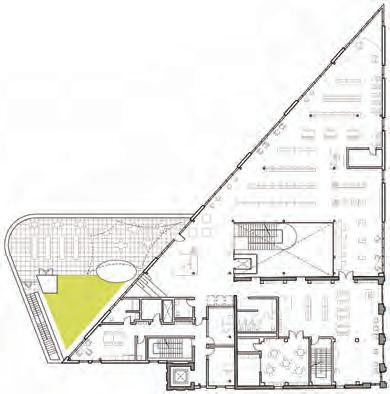

OPPOSITE The building’s elevated form creates a covered outdoor plaza.
TOP The library’s skylight-topped entrance hall provides views to all floors and to the park. ABOVE The tip of the addition includes nooks that invite lounging and socializing.

ABOVE Adjoining the historic fire hall, the main entrance opens into a lofty “agora” space connected to the sheltered outdoor area. Plentiful bike racks encourage active transportation.
space, connected to an interior meeting area. The interior spaces of the library are oriented towards the park.
From a sustainability perspective, the design prioritizes the use of simple systems and materials with local supply chains, including two-storey trusses that use less steel, a ribbed slab with reduced concrete, and exposed mass timber deck and joists. Bricks removed from the existing building will be reused as paving under benches and bike racks, and the stone extracted for geothermal wells will become subgrade for the park’s hard surfaces.
Moreover, the design encourages active transportation and urban agriculture, both of which are popular in the neighbourhood. The outdoor agora includes an abundance of bike racks, as well as public access to bike repair tools and compressed air; planting areas are part of the roof terrace and park, while the library itself hosts a seed library and gardening classes. “We have tried to make a library that says: move your body, eat fresh food, and share with your neighbours,” write the designers. “If this project creates even a small change in the transportation and consumption habits of its users, it will increase social cohesion and reduce the neighbourhood’s carbon footprint two orders of magnitude more than a net-zero building could achieve here.”
CLIENT VILLE DE MONTRÉAL | ARCHITECT TEAM LAPOINTE MAGNE & ASSOCIÉS—KATARINA CERNACEK, PASCALE-LISE COLLIN, ÉMILIE MAUMY, OCÉANE PERHAM, FLORIAN VADJOUX, QIANG FU, MARTIN-F. DAIGLE, SOUBHI JABAL. L’ŒUF ARCHITECTES— SUDHIR SURI, JENNIFER BENIS, EDITH
BEAUVAIS-SAURO, FOTI BOULOUGARIS, ARADHANA GUPTA, BAHIA BURIAS, CAMILLE DEBUISNE, CHLOÉ DEBLOIS, ARIANE DUCHARME | STRUCTURAL L2C EXPERTS-CONSEILS |
CIVIL
| STATUS CONSTRUCTION DOCUMENTS | ANTICIPATED COMPLETION FALL 2027
STRUCTURAL CONCEPT SEISMIC REHABILITATION OF THE EXISTING BUILDING

STEEL BRACING: SEISMIC LOAD TRANSFER TO THE NEW STRUCTURE


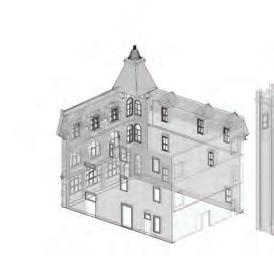






ABOVE The building’s cladding includes steel fins that emphasize the interior structural framework’s four-foot grid. OPPOSITE The reciprocal frame creates a waffle-slab-like grid of wood ceilings, visible throughout the interior.
LOCATION Mont Laurier, Quebec
ARCHITECT Chevalier Morales Architectes
The jury appreciated the architect’s structural, spatial, and compositional commitment to an organizing grid. This design approach can be relentless or unremarkable when handled without variation. This project’s strategy yields a range of nuanced spaces with different light conditions, offering an alternative to overglazed public spaces. – D’Arcy Jones, juror
Nestled in the heart of the Hautes-Laurentides region, at the gate to northwestern Quebec, Mont Laurier is a municipality of 15,000 surrounded by forests and mountains. The region’s growth was historically driven by the province’s developing forestry industry an industry celebrated in Mont Laurier Library’s innovative use of wood.
The design features local engineered wood in an exposed reciprocal waffle frame, the first of its kind for a cultural building in Canada. The reciprocal framing system is a repetitive assembly of short glulam beams of identical eight-foot (2440 mm) lengths. These members, which are tied together by simple connections, cross and support each other in a balancing act that is then delicately placed on round, pin-like columns.
The bi-directional structural pattern of wood is organized in a rigorous four-foot (1220 mm) grid. This measurement is the width of the standard sheets of plywood used as the architectural decking of the system. Overall, the system is designed to minimize waste and maximize



ABOVE The wood ceiling grid integrates acoustics, lighting, fire protection, and other services. A courtyard brings natural light and vegetation deep into the floorplate of the library.
the use of the primary resource of local engineered product. The crisscross woven wood beams are fully visible on the library ceiling, appearing like a pixelated quilt.
The gridded framing system architecturally integrates services including lighting, fire protection, acoustics, and IT. It is mirrored by the use of a raised floor system, which includes a displacement ventilation and air-conditioning system, optimizing thermal comfort for occupants. Through the design process, meticulous attention was paid to the efficiency of the programmatic layout, and its alignments with the grids of the both the structure and floor.
This reciprocal framing concept is conceived as a full-scale prototype for a fully reproducible, factory-prefabricated system. The proposed structural system allows for the complete deconstruction of the framework and reuse of the glulam modular framing elements. The research and design of these mass timber components is being followed by Quebec’s Ministry of Forests, Fauna and Parks. The concept is part of a vision to reduce the production of GHGs in the construction industry through designing for disassembly, stimulating reflection on the lifecycle of building components and on the potential for the decarbonization of our industry.
SAMUEL, OLIVIER

GRATED INTO THE RECIPROCAL ROOF STRUCTURE IN STANDARDIZED OPENINGS
WOODEN STRUCTURE, RECIPROCAL FRAME ON 1220 X 1220 MM (4’) GRID
OPEN STRUCTURAL WAFFLE FRAME
SQUARE MODULAR TILES 610 X 610 MM (2’ X 2’), SEALED CONCRETE FINISH
RAISED FLOOR PEDESTALS
NETWORK OF SPRINKLER HEADS, DUCTING VIA UPPER RAISED FLOOR, GYPSUM OR ACOUSTIC FINISHING PANEL
PASSAGE OF ELECTRICAL CONDUITS IN RAISED FLOOR FOR CONNECTION TO UPPER FLOOR OR FIRST FLOOR
OPEN STRUCTURAL WAFFLE FRAME
125 MM ROUND COLUMN
DIFFUSER GRILLES EMBEDDED IN RAISED FLOOR TILES
PRESSURIZED AIR DISTRIBUTION PLENUM

Ontario Panelization is pleased to now offer Solstex® – Solar Facade System by Elemex®. Colour match ACM around the windows & canopy with the solar panels for a sleek, unified appearance.

LOCATION Toronto, Ontario
ARCHITECT WAO (Wei Architecture & Objects Ltd.)
In an era of increased need for housing, particularly the missing middle, the Annex House project prioritizes hidden density in an established neighbourhood. The project is designed with a unique character that minimizes visual impact from the street while prioritizing access to natural light for all the units, including the lower level. While the proposal to split the project into five units may be challenging, the increase from a single-family home to three unique suites begins to address the need for this housing typology in an ever-growing city. – Matthew Hickey, juror
Some of the major challenges with gentle density are related to access. Multiplexes on narrow lots often forfeit a significant portion of the main elevation to establish a shared entrance. The default alternative is to impose a hierarchical, ‘tradesman’s entrance’ condition on the occupants of the rear dwelling, who must enter their home from the backdoor. Narrow lots are the norm in Toronto’s central, well-established Annex neighbourhood, and recent changes to the city’s bylaws have simplified permitting for laneway houses, garden suites and multiplexes. Annex House resolves the equal-access issue by placing the entrances for each unit along a shared pathway set within its side-yard setback, granting
a pleasant entry experience for all residents, whether they arrive on foot from the main street or by car from the laneway garage.
WAO implemented four strategies to allow three distinct units to coexist on the narrow Annex lot all with privacy and surprisingly generous access to natural light. One: all primary living spaces in the main house’s two interlocking units and in the laneway unit face onto the shared courtyard. The more private orientation makes it possible for extra-large glazing units which maximize daylight and views. Two: a masonry perimeter wall wraps around the pathway that provides access to all three residences; this reinforces the semi-private character of the exterior common spaces and brings the two buildings together to form a unified architectural experience. Three: taking cues from the mansard roofs and dormer windows of the historic Annex homes, the entire upper volume of the main house reads as one vertically-stretched, dormer-set mansard on the street elevation. The mansard overhang provides shading for the large floor-to-ceiling windows and a canopy condition above all three entrance points. On the courtyardfacing elevations, balconies are carved into the sloping roofs of the main house and laneway suite; providing private exterior spaces for each unit. Four: working within building code restrictions that limit openings on the



side facades, Annex House augments access to natural light by introducing an 8-metre-long skylight above a triple-height space, with openings on the adjacent rooms to maximize light penetration. Similarly, lightwells at both ends of the lower unit draw daylight into the basement-level spaces.
The cladding combines conventional brick on the lower levels with cover brick on the sloped upper storeys. Although the cover brick and the regular brick were produced from the same clay, the unit shape of the upper-storey cladding creates a similar effect to timber siding, making it appear lighter more roof-like than the masonry base below.
Annex House is now in construction and scheduled for summer 2025 completion. The submission notes that with minor modifications to the main house’s floor plan, the project’s current three-unit configuration could be converted into four or five units.


LOCATION Calgary, Alberta
ARCHITECT Public City
This entry extracts a lot of impact from a simple palette of bold paint and steel mesh. The design exceeds the client’s expectations by combining a sporty public washroom and pickleball court. Public safety is addressed by reconsidering accepted conventions. One example is exposed washbasins against a glass wall to celebrate an everyday activity in a lighthearted, performative way. – D’Arcy Jones, juror
The Open is a public washroom that is under construction in the East Village of Calgary. It is the winning submission of a national public design competition hosted by the Calgary Municipal Land Corporation. The hybrid architecture and landscape architecture facility marries sport with utility, aiming to transform a functional program into a meaningful urban place.
The architects chose to locate the washroom at the end of 7th Avenue SE, close to existing utilities and intersecting pathways, where it could reinforce the urban edge of both the park and the neighbourhood. To bring an animating activity to the building, the 3,000-square-foot facility houses both a new public washroom and a single pickleball court. This pairing of programs makes the structure large enough to have a presence amongst its 12-storey neighbours, yet light enough at street level to feel transparent and safe within the urban park.
This modest piece of public infrastructure has a social placemaking element that is intended to serve a multi-generational demographic in
Calgary’s burgeoning East Village. Pickleball is the fastest-growing sport in North America, and a free outdoor court brings an active use to the facility countering the common perception of public washrooms as dank, territorial, and in some cases dangerous places. In the architects’ conception, the project is a “mullet”: “business up front, party out back.”
The facility is wrapped with a teal metal screen, and the court is painted with vibrant colours and court lines. At the end of the court, tiered seating encourages spectators to linger. A sedum-planted, wedgeshaped roof nods to the nearby Rocky Mountains.
The firm’s experience with public washroom design over the past fifteen years has shown them that isolating these facilities or turning them into indestructible bunkers only reinforces negative perceptions. “If we intend to make amazing public spaces, then we need to start by composing places infused with value, purpose, activity, and delight,” they write. “One can attract all kinds of activity through design, intentionally or otherwise.”

OPPOSITE The washroom facility is located at the end of 7th Ave SE—a site selected for its visual connection to the centre of Calgary’s East Village neighbourhood. ABOVE A pickleball court and tiered seating activate the facility, encouraging everyday stewardship. BELOW RIGHT A protective fence adds transparent, light massing to the



LOCATION Edmonton, Alberta
ARCHITECT Joint venture between hcma architecture + design and Dub Architects, in collaboration with FaulknerBrowns
There is a sense of conviction in the use of the geometry to create a simple volume and a very rational plan, while incorporating a very large and complex program. The play of berm and cutouts is successful in reducing its apparent size, and in allowing activities to relate to the exterior landscape. The resulting distinctive form achieves a harmony with the other standalone pavilions in the park. The use of copper introduces a material that is reflective at first, contributing to the sculptural aspect. As the copper ages, it will allow the volume to blend into the park. – Andrea Wolff, juror
The new kid on the block Edmonton’s Coronation Park Sports and Recreation Centre aims to play nicely with notable architectural neighbours, while bringing high-performance sport and community recreation together under one roof. Part velodrome and part community athletics hub, the centre is the latest addition to a 35-hectare 1950s city park.
Three existing buildings surround it. The smallest and most charming is Canada’s first public planetarium (1960). The other two are rock stars. The Peter Hemingway Fitness and Leisure Centre (1967) a cable-stayed icon of organic modernism, resembles a gorgeous, partially collapsed glass tent; originally called Coronation Pool, it was renamed after its architect, in 2005. Douglas Cardinal’s science centre (1984), now part of the Telus World of Science, still looks like a spectral seashell/flying saucer, although additions have made it more earthbound than it used to be.
In this illustrious and assertive company, the sleek, elliptical new Sports and Recreation Centre keeps a relatively low profile. It nestles into three large earth berms that, as the award submission states, “optically reduce the height of the building, allowing the existing projects to maintain their standing in the park.”
Behind this deferential exterior, however, there’s a lot going on. A tunnel linking the new Sports and Recreation Centre to the Peter Hemingway centre enables the two facilities to operate in tandem as an indoor triathlon centre–a unique entity, and a valuable one for a city with very cold winters. Velodromes are highly technical facilities where competitive cyclists race at speeds up to 85 kilometres per hour on steeply banked oval tracks. Integrating a velodrome into a community recreation centre makes political sense because it mitigates the potential for an expensive, highly specialized sports facility to become a taxpayer irritation. What is novel about the new Edmonton facility is that its Union Cycliste Internationale-sanctioned cycling track is positioned a full storey above the community centre’s ground-level infield courts. Below and outboard the cycling track, but also above the recreation centre’s courts, is the four-lane running track. By making the cycling track fully visible from recreational activity levels, the design aspires to generate broader community interest in a sport that has yet to acquire a wide Canadian following.
The open, central community space is divided into two levels, with a flexible ‘urban court’ for informal recreation and gathering below the

OPPOSITE The copper-clad sports and recreation centre sits in Edmonton’s Coronation Park. An underground passage connects it to an existing pool, allowing the paired facilities to function as an indoor triathlon centre. ABOVE Sports courts are encompassed by the velodrome track, allowing for dynamic views of the centre’s different activities.


A
offering panoramic views of the surrounding park. ABOVE A sectional perspective shows the relationship between the running path, velodrome track, sports courts, and supporting spaces—a first-of-its-kind approach to a facility containing a velodrome.
TOP A running rings the facility, with offering panoramic views the surrounding park. ABOVE A sectional perspective shows relationship between the path, velodrome sports courts, and supporting spaces—a first-of-its-kind approach to facility containing a velodrome.
upper-level basketball courts. Washrooms and change rooms are tucked under the upper-level courts. Stairs, informal riser-style seating, and best of all, two long, shiny metal slides (!) link these two levels. Other indoor amenities like multiple fitness studios, a café, and childcare space further contribute to programming for users of all ages and abilities. Outside, the landscape design for the new facility expands the range of outdoor activities available at Coronation Park. Still respecting the mature park’s existing context, the refreshed landscape improves wayfinding on a site that became fragmented over time as successive developments eroded the clarity of the park’s original plan.
CLIENT CITY OF EDMONTON ARCHITECT TEAM HCMA— MICHAEL HENDERSON (MRAIC), DARRYL CONDON (FRAIC), PAUL FAST (MRAIC), MICHAEL RIVEST (MRAIC), DARIN HARDING, DEREK HARRIS, JENNIFER SPARKS, CARTER GALLANT, WENDY LI, JASMINE LAM, GENEVIEVE SIMMS, JAMES KOKOTILO, NATHAN KEEBLER, MARCUS VAN VLIET, ALICE ROONEY, AARON BOHNERT; DUB ARCHITECTS— MICHAEL DUB (MRAIC), BOBBY HARRIS (MRAIC), GENE DUB, CASS MILFORD, STEPHEN SMOLSKI, CIARAN BONAR, CHRIS WOODROFFE, GRAEME HAUNHOLTER; FAULKNER BROWNS— MICHAEL HALL, SHERIEF EL-SALAMANI, PAUL RIGBY, ARCHIE WANG, DAVID NOBLE, ANDREW PARKIN, SHIRLEY LUI, CRISTINA UBEDA | STRUCTURAL FAST + EPP | MECHANICAL/ELECTRICAL WILLIAMS ENGINEERING | CIVIL WSP | LANDSCAPE PFS STUDIO AREA 16,500 M2 | BUDGET $150 M | STATUS
CLIENT CITY OF EDMONTON | ARCHITECT TEAM HCMA— MICHAEL (MRAIC), DARRYL (FRAIC), PAUL FAST (MRAIC), RIVEST (MRAIC), DARIN HARDING, HARRIS, JENNIFER CARTER GALLANT, WENDY LI, JASMINE LAM, GENEVIEVE SIMMS, JAMES KEEBLER, MARCUS VAN VLIET, ALICE AARON DUB ARCHITECTS— MICHAEL DUB (MRAIC), BOBBY (MRAIC), GENE DUB, MILFORD, SMOLSKI, CIARAN BONAR, CHRIS WOODROFFE, GRAEME HAUNHOLTER; FAULKNER BROWNS— MICHAEL HALL, SHERIEF EL-SALAMANI, PAUL RIGBY, ARCHIE WANG, DAVID NOBLE, ANDREW PARKIN,LUI, CRISTINA UBEDA STRUCTURAL FAST + EPP MECHANICAL/ELECTRICAL WILLIAMSEERING | CIVIL WSP LANDSCAPE PFS STUDIO | AREA 16,500 M2 | BUDGET $150 M STATUS UNDER CONSTRUCTION ANTICIPATED COMPLETION 2026



LOCATION Tofino, British Columbia
ARCHITECT Leckie Studio Design + Architecture
Interventions that recognize the importance of place are key to designing appropriate structures. The Tofino fish pier is just this an intervention that celebrates the importance of the existing vernacular through minimal contemporary interventions that visually integrate into the collection of constructions. The work is respecting the past, while considering contemporary ways of elevating the existing buildings. The focus on culture and surrounding community further enhances this work, and strengthens its purpose as a part of the heritage of this place. – Matthew Hickey, juror
In 2009, the BC Supreme Court recognized the Aboriginal rights of the five Nuu-chah-nulth Nations Ahousaht, Ehattesaht/Chinehkint, Hesquiaht, Tla-o-qui-aht, and Mowachaht/Muchalaht to catch and sell all species traditionally harvested within their territories. Since then, Canada and the Five Nations have been exploring ways to develop economic fisheries that benefit First Nations and coastal communities. However, fifteen years later, most T’aaq-wiihak fishermen (that is, those who conduct fishing with the permission of the Ha’wiih, or hereditary chiefs) still lack a physical hub to fully realize the economic, social, and political potential recognized by these Indigenous rights.
Located within the traditional land (Ha-Hoothlee) of the Tla-oqui-aht Nation, the Tofino Fish Pier aims to create such a hub, providing a unique opportunity to support Tla-o-qui-aht stakeholders while
engaging in the decolonization and adaptive reuse of a colonial landmark. The original fish pier was constructed in 1962 as a prawn and salmon processing facility for the Tofino Packing Company, and later expanded with a large ice plant for filling the storage holds of deep-sea fishing trawlers. Today, it stands as one of the last remaining purposebuilt timber ice plant structures on the West Coast.
The project guided by the Nuu-chah-nulth word kwisłap, meaning ‘do things differently’ aims to preserve Tofino’s architectural landmark, while creating a safer, more inclusive space for Nuu-chah-nulth peoples. The ice plant is being repurposed as a gathering space and exhibition room for Nuu-chah-nulth artists and events, topped with a First Nations artist residency studio in the former mechanical loft. It will also include a marine research and education wet-lab and Coastal Nations Auxiliary Coast Guard deployment office. Cannery buildings will be repurposed as Nuu-chah-nulth fisheries offices and community spaces for Indigenous marine education, as well as hosting a pop-up seafood café during peak tourism season.
Future phases anticipate the restorative dredging and expansion of the historic basin to reintroduce a marina, the construction of a pavilion for fish landing and grading, and the construction of a new pier to host a seasonal Nuu-chah-nulth Market and to support Indigenous-led marine tourism activities.

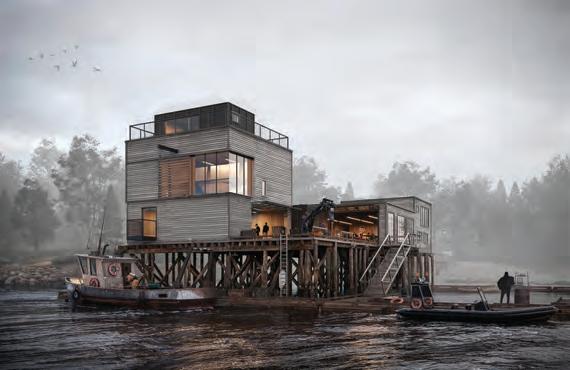

EXPLODED AXONOMETRIC
PHASE 1 “ICE BOX” GATHERING AND EXHIBITION ROOM ROOF DECK AND ARTIST RESIDENCY STUDIO T’AAQ-WIIHAK OFFICE AND COMMUNITY ROOM FIRST NATIONS MARINE RESEARCH AND EDUCATION COASTAL NATIONS COAST GUARD AUXILIARY OFFICE PHASE 2
T’AAQ-WIIHAK MARINA “FISH RATTLE” LANDING AND GRADING PAVILION PHASE 3 FIRST NATIONS MARKET FIRST NATIONS MARINE TOURISM FLOATS TIDAL BENCH MARINE PARK
OPPOSITE The project adaptively reuses a historic fish processing facility and ice plant as a hub to support First Nations fishermen. ABOVE LEFT
A central gathering area connects a new First Nations fisheries office and an exhibition room for First Nations artists and events. ABOVE RIGHT
The project builds on the existing structures, with architectural interventions focused on introducing daylight, establishing connections, increasing safety, and supporting new programs.
The vision for the Tofino Fish Pier is founded on long-term partnerships with Tla-o-qui-aht start-ups and non-profit organizations that uphold Nuu-chah-nulth principles of stewardship and foster community empowerment through promoting traditional values. Overall, the project aims to reappropriate this colonial industrial fishing landmark as a means to support reconciliation with Nuu-chah-nulth peoples, serve underrepresented communities, and celebrate Canada’s diverse heritage.
(PHASE 1)

LOCATION Petite-Rivière-Saint-François, Quebec
STUDENT Rosalie Laflamme, Université Laval
ADVISOR Thibault Nguyen
This project honours rural heritage through a sophisticated, simple and elegant approach. A series of pavilions is anchored by a stone wall that creates a strong axis running parallel to the train tracks and river. The pavilions are designed as separate entities, each with a purpose, and open to the river, adding to the sense of nostalgia. The use of regularly articulated open wood bays provides a warm contrast to the stone screen. – Andrea Wolff, juror
Like many rural centres, the Charlevoix village of Petite-Rivière-SaintFrançois is increasingly becoming disconnected from its heritage. This is due to a variety of factors, including the exodus of local residents following the modernization of rural work in the 1970s, and the tendency for new developments to be out of scale and out of character with the vernacular.
This project aims to restore Petite-Rivière-Saint-François’ built and intangible heritage through a program to protect, preserve, and transmit rural heritage. The project consists of a pair of pavilions, connected by a rubble stone wall that extends across a site between the village’s cliff and the Saint Lawrence River. It runs alongside the visible and invisible axes of the site: a pedestrian lane, the railway, the stream, and the river.
To the north, on a narrow plot bounded by Gérard’s stream, Quay street, the river and a grove, the Mother Pavilion hosts residential spaces for visiting artisans. 130 metres to the south, surrounded by mature trees, the Practices Pavilion provides areas for fishermen, carpenters, and craftsmen to perfect their art, preserving the heritage of ancestral crafts. Large workshops are dedicated to ship building, carpentry, maple syrup production, weaving, and eel preparation all traditional practices from the region. Rubble stone walls define the main spaces and circulation axis, while large chimneys compartmentalize the rooms and are integral to the program.
As a whole, the project seeks to form new connections between artisans, villagers, and visitors, resensitizing residents to the territorial wealth of the region.


OPPOSITE TOP The Practices Pavilion includes spaces for traditional artisans to engage in shipbuilding, carpentry, maple syrup production, weaving, and eel preparation. OPPOSITE BOTTOM A stone wall links the two pavilions, while sheltered exterior corridors provide access to the studios. ABOVE Large stone chimneys anchor the design and support the program in ways that include being integral to the maple syrup production process.

















LOCATION Toronto, Ontario
STUDENT Matthew Dlugosz, University of Waterloo
ADVISOR Lola Sheppard
This project is a sober study of a current trend in church building reuse that is occurring across Canada. The Parkdale People’s Palace illustrates multiple interventions in an existing church and residential building that elevate and expand the program possibilities, while prioritizing food security and strengthening community. The thorough study of “what could be” in the existing spaces is diagrammed in a manner that is visually convincing. – Matthew Hickey, juror
In recent decades, the decline in use of Canada’s church buildings has highlighted the need for creative approaches to adaptive reuse. This project builds on the existing needs of the South Parkdale community, west of downtown Toronto, to propose the reinvention of a church slated for revitalization into a community food hub.
Designated a Neighbourhood Improvement Area, South Parkdale demonstrates a commitment to social equity in the face of gentrification. Within the neighbourhood, Bonar-Parkdale Presbyterian Church was selected for its signs of disrepair and intent for revitalization. Inspired by key community directions and community-oriented design precedents, this thesis proposes to add vital social infrastructure to the area.
The project aims to provide a relevant ensemble of spaces and programs that will revitalize the church property, allowing it to become a common meeting ground for community members of diverse ages and socio-economic backgrounds. The plaza invites farmer’s markets, the basement holds a food co-op, and a commercial kitchen accommodates the preparation of meals for large events. Behind the church, an extensive community garden includes raised beds for accessibility. A co-op café fronts the building, while a teaching kitchen and hydroponics area are tucked towards the back.
The existing sanctuary is transformed into a multipurpose atrium, framed by a wood scaffold equipped with elements that maximize flexibility of use. A set of retractable bleachers and stage allow for screenings, lectures, or performances. Retractable lights, rotating ceiling baffles, and shutters can be used to adjust lighting and acoustics. The space can also be used for celebrations, indoor markets, large social dining events, or informal co-working.
The design proposal imagines the potential of a heritage asset in providing crucial social supports to communities and, by extension, to the city at large.







STUDENT Jose Power, University of Toronto
Jeannie Kim
ADVISOR
The jury was delighted by this project’s witty and irreverent reworking of generic elevator spaces in residential buildings. Emphasizing the differences between people’s wants and needs, the design proposes new short-term communal uses, such as moving coffee shops, speed-dating tables, or speakeasies. –
D’Arcy Jones, juror
In the late 1800s, the arrival of the first high-rise buildings was coupled with worries about the inconveniences and possible dangers of living far from the ground. To counter these anxieties, the first elevators were created as opulent amenities and social hubs in buildings. They were revered as “ascending rooms” where slowness was embraced as a luxury.
As the demand for taller structures grew, speed and efficiency took precedence, relegating elevators to merely serving as vertical transportation.


And yet, elevators remain one of the few places where the otherwise disconnected lives of today’s highrise residents converge, albeit briefly.
Ascending Worlds nods to the elevator’s historical significance and spatial essence, embracing its velocity, scale, and temporality to reveal a realm ripe with social possibilities. The project redefines the elevator as a catalyst for architectural innovation, capable of reshaping communal dynamics within residential towers.
Ten different elevator prototypes are suggested in the thesis, each taking up the space of one or more conventional elevator bays. The two-elevator-wide Express Café offers residents a chance to grab a barista- pulled espresso on their way downstairs, and exchange greetings with other residents. The multi-level Venue includes a lower storeystage and comfortable seating on upper balcony levels for acoustic miniconcerts. The one-elevator-sized Matchmaker includes a cozy interior with a small table to set the stage for an intimate conversation between two individuals. If the chemistry is right, either participant can slow down the journey or conversely, they can also opt to discreetly access the “speed up” or “emergency exit” buttons under the table to bring the blind date to a quick end.
The designs are not dictated by the typical restrictions of vertical transportation, but are shaped by the quality and duration of the potential interactions that our present-day ascending rooms may evoke. Ascending Worlds endeavours to reignite the allure of the elevator, infusing it with newfound vibrancy and significance within our evolving urban landscapes.
This unique space offers a range of enticing amenities, including a full-sized bar and comfortable lounge seating. Here, residents can savor a quick drink before heading back to their units or opt to linger and socialize with fellow neighbours. The Speakeasy is also designed to cater to residents looking for swift vertical transit, with ample standing room near the door for efficient boarding and alighting. The Speakeasy is equipped with a cutting-edge Call and Push Button System, allowing residents to summon the elevator while placing an order for their preferred beverage.
In our quest for a few extra moments each morning, the Express Cafe emerges as the perfect addition to any highrise. Complete with a full-service cafe, it offers residents the luxury of grabbing their morning coffee on their way down to kickstart their day. Despite its compact footprint, the interior is designed to foster social interaction, providing ample space for residents to gather as they await their orders. Unique Call and Push Button Systems adorn each floor, allowing residents to conveniently place their orders while summoning the elevator.
The Library offers residents an ideal space to exchange their favourite reads, simply by leaving one behind and picking up another left by a fellow resident. Comfortable benches invite residents to linger and immerse themselves in the serene interior, whether diving into a book or engaging in friendly conversations with neighbours. The Library ensures an efficient use of space and time, providing residents with a distinctive and inviting environment without compromising on convenience.
Elevators, both in reality and media, have long been portrayed as discreet settings where romance, or even affairs, can blossom. This ascending room requires two curious residents to join forces to activate. Upon entry, a cozy interior with a conversation table sets the stage for intimate conversations between two individuals. If the chemistry is right, either participant can choose to slow down their journey. Conversely, if the encounter takes a turn for the worse, a participant can discreetly access the “Speed Up” or “Emergency Exit” buttons located under the table.
Feeling the need to unburden yourself but unsure of where to turn?
Throughout both real-life experiences and depictions in media, the elevator has often provided a haven for individuals to share their deepest secrets in a secure environment. The Confessional offers residents the opportunity to confide in a stranger before parting ways, ensuring complete anonymity with separate entrances for both parties. The Confessional prioritizes a slower pace of movement compared to traditional large elevators and occupies the space equivalent to about two standard elevators.
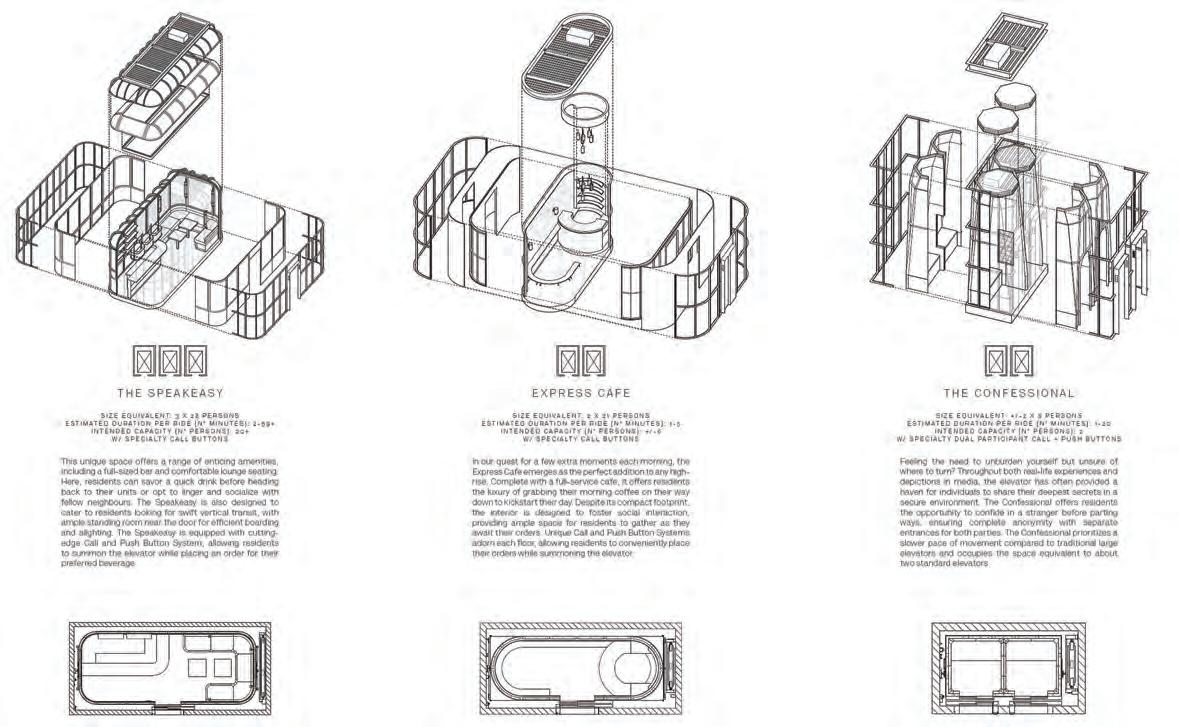

Elevating the concept of elevator music to new heights, The Venue promises to captivate residents in any tower. This multi-level ascending room is meticulously crafted to deliver live music and entertainment as residents journey up and down the tower. Paired with a stage below, comfortable seating invites residents to sit back and immerse themselves in the performance, while acoustic panelling ensures an exceptional listening experience. Whether it’s a brief trip or a late night stay, The Venue guarantees to add an entertaining touch to anyone’s day.



THIS YEAR’S JURY SELECTED FOUR OUTSTANDING IMAGES TO BE RECOGNIZED WITH CANADIAN ARCHITECT PHOTO AWARDS. HERE ARE OUR WINNERS.
There is an honest, direct beauty to this photograph qualities that seem to be mimicked in the design of the space itself. Without seeming staged, the scene authentically captures a quiet moment in a school auditorium. The composition wonderfully frames the subject matter with the shape of the triangular window mirroring the child and her belongings. I appreciate the “sweet spot” that the photographer has found: they placed themselves close enough to show material details, but are also far enough away to evoke a sense of the overall space. – Lisa Stinner-Kun, juror
I’m generally interested by indirect, soft light in the pictures I make. Large triangular roof-light chimneys in the pavilions at École du Zénith funnel diffused daylight down into the interior spaces from above, creating moments of delight. Located at the foot of Mont Shefford near Montreal, the school is part of an experimental collection curated by Lab-École, an initiative launched in 2019 to review and explore the way primary schools are designed in Québec. The image is from a series commissioned by Montreal’s Pelletier de Fontenay.
This is a sophisticated and transformative photograph of a 1970s building and entrance an era ubiquitous in our built environment. The shadows are creatively seen and used as part of the composition. The photograph masterfully captures and celebrates the everyday beauty of a humble building material that has been deployed in a subtle way. – Lisa Stinner-Kun, juror
A very thoughtful, painterly interpretation of La Tour du Port. The light at dawn helps to create a magical scene, and as the artist states, successfully helps to merge the “feeling of the past and present.” The photograph is a serene confluence of multiple time periods. It is always challenging to photograph wide, landscape views of urban environments in such a way that all of the buildings and structures feel purposefully placed in the frame. But here in this photograph, the multitude of details are all beautifully composed. – Lisa Stinner-Kun, juror
Douglas Cardinal’s ability to create diversity and complexity with a simple, singular material speaks to his commitment to harmony, and his masterful control over form. Through my lens, I sought to show how Cardinal’s careful use of material and form allows a structure to feel both monumental and intimate, offering layers of meaning and a sense of quiet grandeur. This image not only reflects my appreciation for Cardinal’s work, but also my belief in the transformative power of restraint, expertly applied.
This well-documented church by Étienne Gaboury is captured here in a new and exciting way. The composition and angle of view seem to transform the building into a sculptural object. There is a wonderful contrast between the clarity of detail which is exaggerated by the lowcontrast, overcast sky— and the mysteriousness and ambiguity of the building’s context. – Lisa Stinner-Kun, juror
Montreal’s new Tour du Port draws on the language of the old port’s industrial past abandoned grain silos, cranes and elevators. The new tower’s cantilevered platform is set at a height to create a dramatic contemporary frame for viewing the port and the city’s downtown core. I made several unsuccessful early morning visits to the port in the hope of interesting light, before settling on this view to show the conversation between old and new, as well as a sense of new beginnings.
As a primarily Métis parish, this church’s form makes reference to the tipi. The glulam fir beams resembling the poles that support a tipi create a sturdy framework for the cedar-shake roof while defining an infiniteseeming interior space. Carefully placed windows are located under the eaves and at the peak of the spiral, directing light towards the altar below and promoting an atmosphere of transcendence. In this photograph, I attempt to bring focus to that source of light, acknowledging the clerestory windows that are hidden within the peak of the spiral.









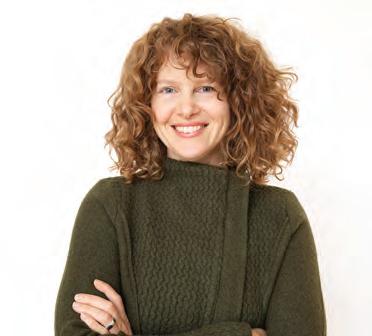
Matthew Hickey is Mohawk from the Six Nations of the Grand River Reserve. He oversees design and development at Two Row Architect, where he has practiced for 18 years. Two Row’s core focus is on Indigenous design and architecture, designing buildings, landscapes, and installations, on and off reserve in locations all over Turtle Island.
Matthew carries a focus on regenerative and restorative design encompassing ecological, cultural, and economic principles. His work pushes the concepts of universal inclusivity through integrated landscapes, food equity, the importance of water, and placekeeping for all species, including humans. His research includes Indigenous history in the architecture of Northern and Middle America, and the realignment of western ideology towards historic sustainable technologies.
As a tenure-track professor at OCADU, Matthew believes that giving back and encouraging younger generations is the key to moving our way of thinking about design and architecture forward. Matthew has lectured widely, and is a member of the Waterfront Toronto Design Review Panel, a Mentor at Nikibii Dawadinna Giigwag, and a recent member of the Urban Land Institute’s Advisory Committee.
D’Arcy Jones is an architect and writer. He is the principal of D’Arcy Jones Architects (DJA), a Vancouver practice established in 2000 and recognized for design excellence. Dalhousie Architectural Press recently published D’Arcy Jones Architects: 2009-2020, a monograph about the studio’s work and design process. Jones holds a Doctor of Design from the University of Calgary.
DJA’s ideas and responses to contemporary conditions have earned awards and publications nationally and internationally. Practice honours include an AIBC E merging Firm Award, an RAIC Emerging Architectural Practice Award, and the Ronald J. Thom Award for Early Design Achievement from the Canada Council for the Arts. Project honours include a Mies Crown Hall Americas Outstanding Project Award, an AFBC D esign Excellence Award, two AIBC L ieutenant Governor Awards, and three Canadian Architect Awards.
Jones has been a juror for various award programs. Recent assignments include the RIBA (UK) International Awards, the RAIC A nnual Awards, and chairing the AFBC A rchitectural Awards of Excellence.
Andrea Wolff is a founding principal of ARCHITEM Wolff Shapiro Kuskowski architectes, established in Montreal in 1986. The firm was initially created to provide balance and promote family values within a competitive and demanding profession, never losing sight of its commitment towards excellence. The all-woman partnership was remarkable for the time, and the firm has prospered for close to 40 years.
ARCHITEM has now evolved into a diverse team where new principals continue the vision of teamwork. The design and execution of every project is enriched through careful listening and collaboration between professionals, builders and clients. The firm specializes in the design of high-end residential, commercial and private institutional projects, many of which have been recognized nationally and internationally, including The Unitarian Church of Montreal, McGill University’s William and Mary Student Services Building, Browns Head Office and Distribution Centre, 15 Belvedere, The Old Brewery Mission Cafeteria, and Bishop’s College School Mitchell House.
Andrea has served on the board of the Quebec Association of Architects in Private Practice and the Maison d’architecture du Quebec. She also lends her expertise to the boards of the Montreal Sexual Assault Centre, the Patricia McKenzie Pavilion of the Old Brewery Mission, the corporation of the Lethbridge Layton Mackay Rehabilitation Centre, and the Planning Advisory Committee of Potton.
Lisa Stinner-Kun is a photographic artist and architectural photographer based in Treaty 1 Territory (Winnipeg, Manitoba).
Her artwork is concerned with the photographic reconstruction of the human-built world. Since graduating from the School of the Art Institute of Chicago with an MFA , Stinner-Kun has shown her photographic work in exhibitions nationally and internationally. Her New Material project was recently featured in the Moving Matter exhibition at the SOAG Gallery (Winnipeg) and she has an upcoming solo exhibition at the Centre for Cultural and Artistic Practices (Winnipeg). Her Construct series was recently featured in Medium Format Magazine, and she is a two-time recipient of a Canadian Architect Photo Award of Merit (2020/22).
The Canada Council for the Arts, Manitoba Arts Council and Winnipeg Arts Council are supporting the creation of her most recent project, Mid-Century Modest. Stinner-Kun is currently teaching at Martha Street Studio and is a frequent instructor at the University of Manitoba’s School of Art, where she received her BFA

From concept to construction, we’re ready with an extensive building envelope portfolio to meet your residential and commercial needs.

• Extensive portfolio – windows, siding, composite cladding, doors and rainware; interior walls, ceilings and column wrap products
• Design visualizer and sales presentation tools
• Central document hub with instant access in your preferred formats
• Tech support team and specifying services customized to your project
• Transparent, competitive pricing and comprehensive material assemblies for streamlined efficiencies
• Sustainable solutions to help elevate your LEED certification journey
• Nationwide service, local convenience – we’re here to help no matter where your project takes you!
Learn more about the unmatched advantages of Gentek products and our Commercial Division team. Visit www.gentek.ca/professionals/architects/ gentek.ca | Make us a part of your home.

